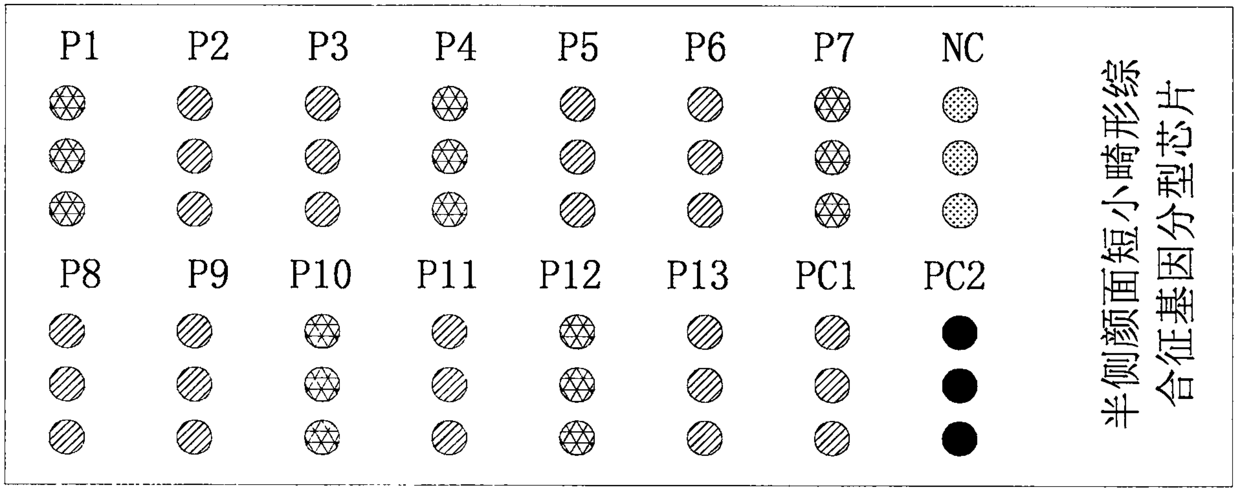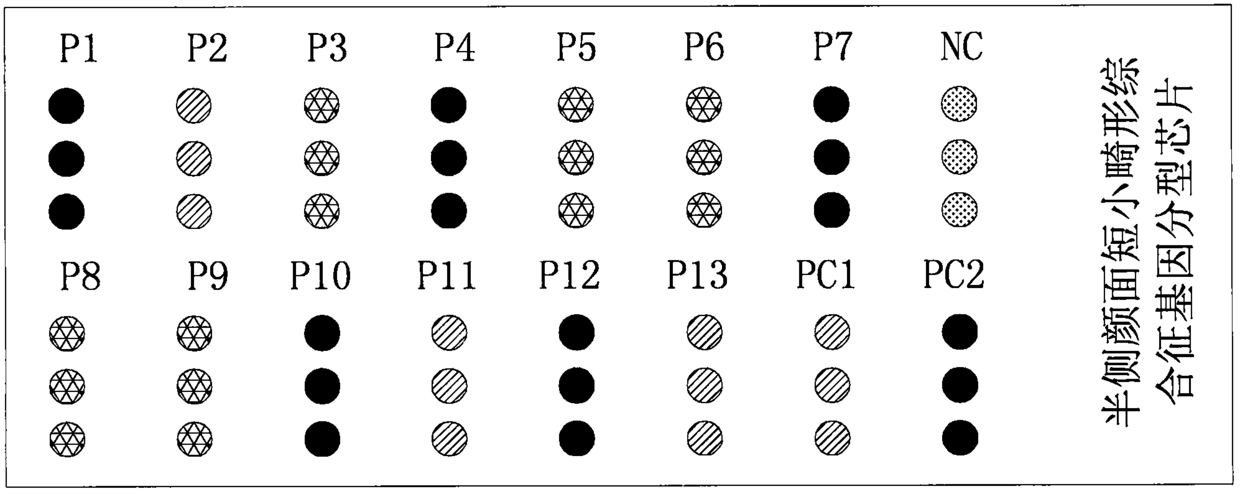Gene chip for non-invasive prenatal assessment of hemifacial microsomia, kit and application method of gene chip
A gene chip and application method technology, applied in the fields of medicine and biology, can solve problems such as mental and physical pain, and achieve the effects of reducing patient pain, shortening time, and saving cost and time
- Summary
- Abstract
- Description
- Claims
- Application Information
AI Technical Summary
Problems solved by technology
Method used
Image
Examples
Embodiment 1
[0057] A gene chip for non-invasive prenatal assessment of hemifacial short syndrome, the gene chip includes a film base, on which a probe group for detecting genes related to hemifacial short syndrome is provided to form a microarray gene Chip; the probe set includes 13 probes, and the sequence of each probe is as follows: (1) probe P1: its nucleotide sequence is AGAGTAATGCTGTCCATTGCCCA; (2) probe P2: its nucleotide sequence is AAGATATTCACTCTCTGGCTAGGCCTA; (3) probe P3: its nucleotide sequence is ATATGAAATAAGGAGGAGATAAGAGA; (4) probe P4: its nucleotide sequence is GCTGGGATTACAGGCATGAGCCACTGT; (5) probe P5: its nucleotide sequence is AAAGAAAATATCTCAAAAGAATCAAC; (6) Probe P6: its nucleotide sequence is AAGCTCAGGGGCTCAGGAGGCAGGA; (7) probe P7: its nucleotide sequence is CTGAATCCTTGTTGGCTTCAGAGTCAG; (8) probe P8: its nucleotide sequence is CTGATCCTCTGAGGGATTGATGACA; (9) probe P9: its The nucleotide sequence is TAAAGTGGGAGGATTGCTTGAGCCC; (10) probe P10: its nucleotide sequence is ...
Embodiment 2
[0065] A method for preparing a gene chip for non-invasive prenatal evaluation of hemifacial short syndrome, in which a glass slide is selected as the carrier sheet of the gene chip, and the preparation of the gene chip then includes the following steps, in order: (1) Acid-base pretreatment of glass slides; (2) aldehyde treatment; (3) isothiocyanation treatment, (4) chip probe design; (5) probe spotting; (6) spotting completed chips Place and bake at 80°C for 10 minutes to make microarray slides; (7) Store in a box with a desiccant and store at room temperature.
[0066] In this example, the preparation method can be prepared by conventional methods, and the emphasis is on the gene chip itself rather than its preparation method.
Embodiment 3
[0068] A kit for non-invasive prenatal risk assessment of congenital hemifacial short syndrome, the kit includes the gene chip described in Example 1.
[0069] The kit also includes a primer set, the primer set is preferably 13 sets of primers, and the 13 sets of primers are as follows:
[0070] (1) Primer set 1: ①Primer F1: its nucleotide sequence is ATTCCCCTTCATCATTGTC; ②Primer R1A: its nucleotide sequence is GGTCAGCTTAGTATCCAGG; ③Primer R1: its nucleotide sequence is GGTCAGCTTAGTATCCAGA;
[0071] (2) Primer set 2: ①Primer F2: its nucleotide sequence is TGGATTCTACATTTCCTAA; ②Primer F2A: its nucleotide sequence is TGGATTTCTACATTTCCTAG; ③Primer R2: its nucleotide sequence is GGCAGTAGTGATAGGAGAA;
[0072] (3) Primer set 3: ①Primer F3: its nucleotide sequence is TTAGAAAATGGTTAAGTGT; ②Primer F3A: its nucleotide sequence is TTAGAAAATGGTTAAGTGG; ③Primer R3: its nucleotide sequence is ACTCCAGCTAGAGGTAAAT;
[0073] (4) Primer set 4: ①Primer F4: its nucleotide sequence is GACCTTAGGTG...
PUM
 Login to View More
Login to View More Abstract
Description
Claims
Application Information
 Login to View More
Login to View More - R&D
- Intellectual Property
- Life Sciences
- Materials
- Tech Scout
- Unparalleled Data Quality
- Higher Quality Content
- 60% Fewer Hallucinations
Browse by: Latest US Patents, China's latest patents, Technical Efficacy Thesaurus, Application Domain, Technology Topic, Popular Technical Reports.
© 2025 PatSnap. All rights reserved.Legal|Privacy policy|Modern Slavery Act Transparency Statement|Sitemap|About US| Contact US: help@patsnap.com



